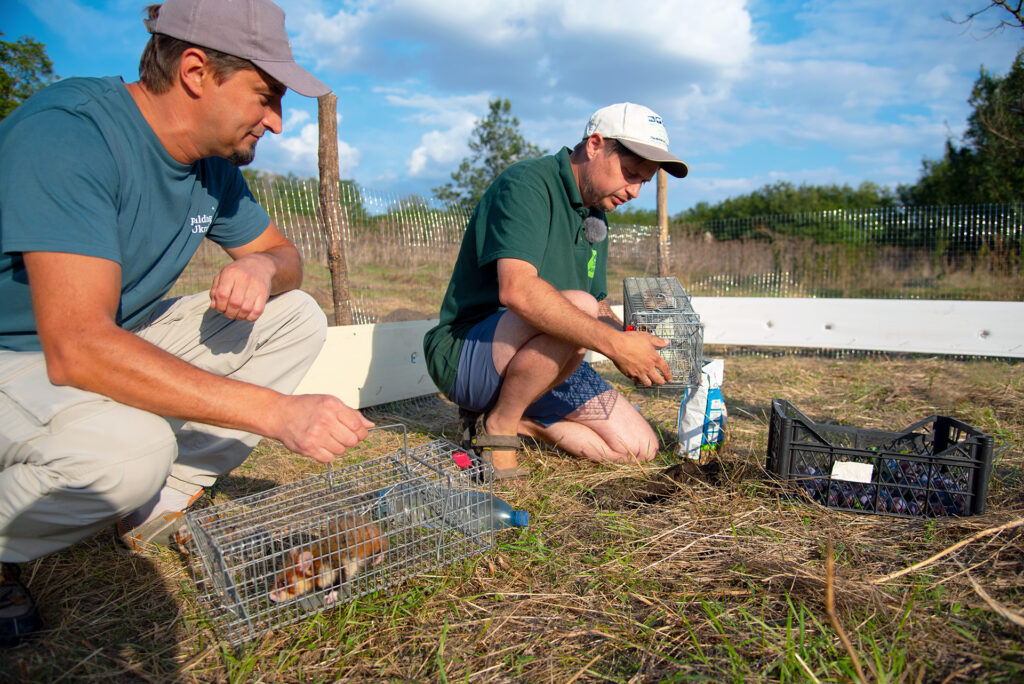The Rewilding Ukraine team are engaged in long-term efforts to create a wilder and healthier Tarutino Steppe. The ongoing reintroduction of European hamsters will help to restore local food webs, enhance biodiversity, and boost nature-based tourism.

 Towards a wilder steppe
Towards a wilder steppe
A group of 15 European hamsters (eight females, seven males) has been released on the Tarutino Steppe in the Danube Delta rewilding landscape in Ukraine. This is the second release of a reintroduction programme overseen by the Rewilding Ukraine team, in collaboration with Kyiv Zoo and the Tarutino Steppe Nature and Ethnographic Park, with a family of three already released late last year. The burgeoning presence of the diminutive rodents, which were once widespread across Ukraine, will contribute to the creation of a wilder and ecologically healthier steppe landscape, helping to restore local food webs and enhance biodiversity, as well as boosting nature-based tourism.
Positive impact
Compared to hamsters kept as pets, wild hamsters are quite large – they can reach up to 30 cm in length and weigh more than 500 g. They spend 95% of their time underground in burrows, venturing out only at dawn and nightfall to feed mostly on plants. On the Tarutino Steppe they will help to disperse seeds, while their burrows will create habitats for many other wildlife species and improve soil fertility. The animals themselves are important prey for a range of birds and mammals. They will also help to attract tourists and support development of the area’s developing nature-based economy.
“The primary importance of burrowing animals, primarily rodents, on the Tarutino Steppe, lies in the transformation of the soil and vegetation cover,” explains Oleg Dyakov, a rewilding officer attached to the Rewilding Ukraine team. “They improve the composition, aeration and water permeability of the soil and affect vegetation by eating various types of plants. Rodents such as hamsters also serve as the main food body for almost all steppe predators.”

Essential conservation
Kyiv Zoo has been breeding and returning European hamsters to the wild for a few years as part of a programme to restore populations of rare and endangered species across Ukraine.
The European hamster once inhabited steppes and forest-steppes across Europe, and was resident in most of Ukraine. But today it has almost disappeared in nature as a result of habitat destruction, environmental pollution, and targeted extermination as an agricultural pest. In 2009 it was listed in the Red Book of Ukraine. On the Tarutino Steppe the rodents will benefit from environmental protection and an increasingly wild landscape.

Ongoing programme
The released hamsters will initially be kept in an enclosure of 600 square metres, allowing them to acclimatise themselves and form a colony in complete safety. Once this happens the enclosure will be removed. The hamster reintroduction programme will continue, with more releases planned for next year – the eventual aim is to establish colonies in a few places across the Tarutino Steppe. Although it is difficult to monitor them, the hamsters released last year are thought to be doing well.
European hamsters are the latest in a line of native herbivorous animals returned to the Tarutino Steppe by the Rewilding Ukraine team, with kulan (Asiatic ass), European fallow deer and steppe marmot populations all doing well. The combined impact of all of these species will improve the health and resilience of the steppe landscape.
The Tarutino Steppe restoration is part of scaled-up rewilding efforts in the Danube Delta rewilding area, which began at the start of 2019 with funding provided by the Endangered Landscapes Programme. On the Tarutino Steppe, these efforts are aimed at restoring a wilder steppe governed more by natural processes, such as natural grazing.

